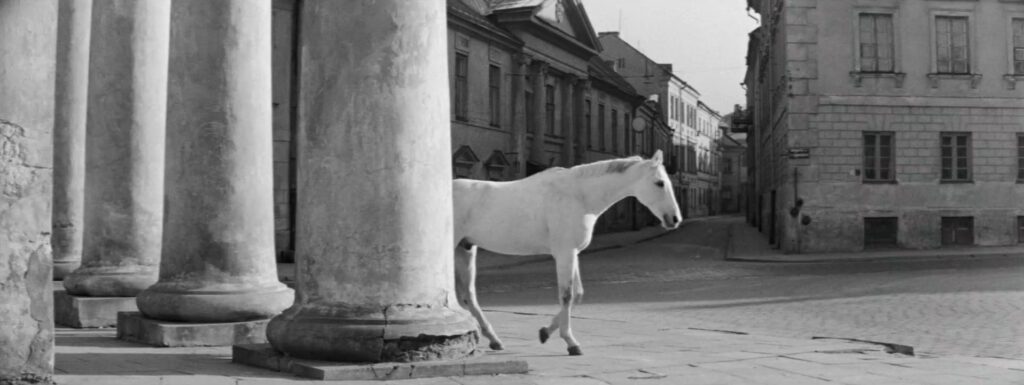
Time Walks Through the City
1966, directed by Almantas Grikevičius
Time Walks Through the City is a 17-minute cinematic tour of Vilnius, interrupted by a passage where time seems to stand still. This type of film is usually called “experimental” or “documentary”, or in this case a “city symphony”, but those labels tempt us to see the film for less than it actually is. They mislead even if they’re not wrong. The film is neither an experimental exercise nor merely a stylized survey of Vilnius, but rather an affirmation of hope for the people of Lithuania. It puts the country’s situation in a broader perspective of time, looking at time in its various manifestations:
- In the opening shots the pendulum, gears, and bell of Vilnius Cathedral’s tower all point to clock time, or measured linear time.
- After the bell tower, the statuary in the cathedral’s pediment frieze is the first of many images to evoke eternity, a kind of frozen or unchanging layer of time.
- The following panoramas juxtapose old and new architecture, collapsing the span of history. Likewise, traditional ceremonies (weddings, flower laying) are intercut with modern life (soccer, motor sports, rock music, street dancing).
- Children and adults mix on the streets of Vilnius, while youthful gatherings alternate with aging persons and a cemetery. The turnover of generations hints at a cyclical view of time.
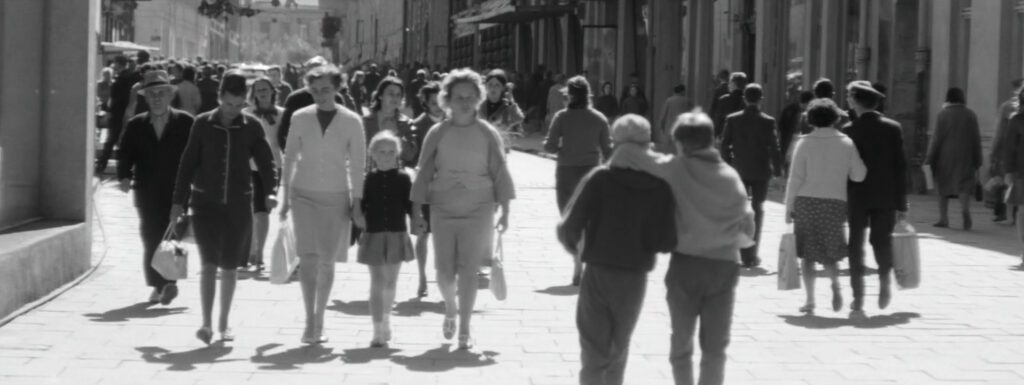
There were compelling reasons for a Lithuanian to make a film about time in 1966. Like its Baltic and Eastern European neighbors, the country had already spent more than twenty years under the oppressive thumb of Moscow. Once a large, prosperous, and powerful country, Lithuania had been occupied by the Russian Empire through the 19th century, regained independence toward the end of World War I, and fell under Soviet occupation during World War II. After the film’s release it would take another twenty-five years to win independence again in 1991. It’s not hard to imagine that time weighed heavily on a proud nation thus entrapped.
The film, of course, had to hide its intentions. A single image of a Lenin statue followed by two quick shots of a Soviet parade were probably enough to satisfy Soviet censors, placed strategically only seconds after the subversive image of pigeons walking on an inscription of 1863, the year Lithuania joined Poland in the January Uprising against czarist Russia. The central role given to Lithuania’s capital also must have appealed to Baltic patriots, but the Soviets probably dismissed that as an inevitable part of filmmaking. Their goal was not to exclude occupied countries from Soviet culture, but to assimilate them. All the Roman Catholic churches and religious imagery could have stirred nationalistic feelings, but they’re safely blended into a modern context without any clear religious message. Soviet authorities probably regarded all the religion merely as historical background, the same way they tolerated the existence of churches.
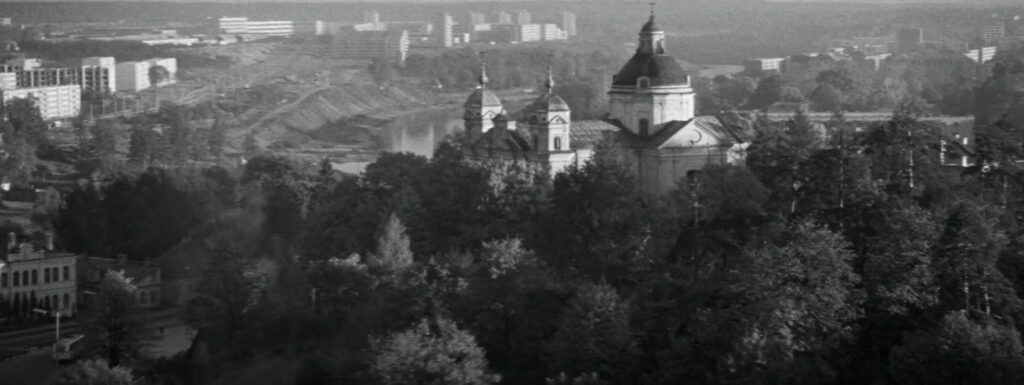
More subtle however than the allusion to 1863 is the long sequence in the Church of St. Peter and St. Paul, a baroque church built to commemorate the expulsion of Muscovites from Vilnius in the Russo-Polish War, an outcome that Lithuanians dreamed of repeating. The church first appears two shots before the main title, separated only by a single shot of modern housing across the river, then it returns six minutes later for a 66-second montage of the stucco reliefs inside. Like the first exterior shot, this montage holds a privileged place in the editing, immediately before the signature image that enters almost exactly halfway through the film – the white horse trotting in slow motion like Time itself walking through Vilnius. The montage in the church ends with a white stucco horse, so that the living horse, in this cut, springs as if from the church’s plaster like a miracle. If the church represents Lithuania’s freedom from Russia, this horse is that same dream brought to life, unfrozen after centuries of history.
The white horse is the centerpiece of the film, and also of its central passage, the eight and a half minute interlude (half of the film’s running time) that brings the bustling city to a standstill. Time freezes at a busy intersection, then some flashes of light and a passing airplane suggest a nuclear attack, a possibility easy to imagine so soon after the Cuban Missile Crisis. A series of still images expresses the panic of events not properly recorded; a skewed shot of railroad tracks tips the picture out of balance; and a row of telephone receivers hangs loose off their hooks, as if abandoned in a hurry. The montage of stucco figures extends the frozen horror of the still photographs until the horse enters. The horse is enigmatic, an apocalyptic but also a peaceful image. Finally the sequence returns to the busy crossing, and the city resumes its previous vitality.
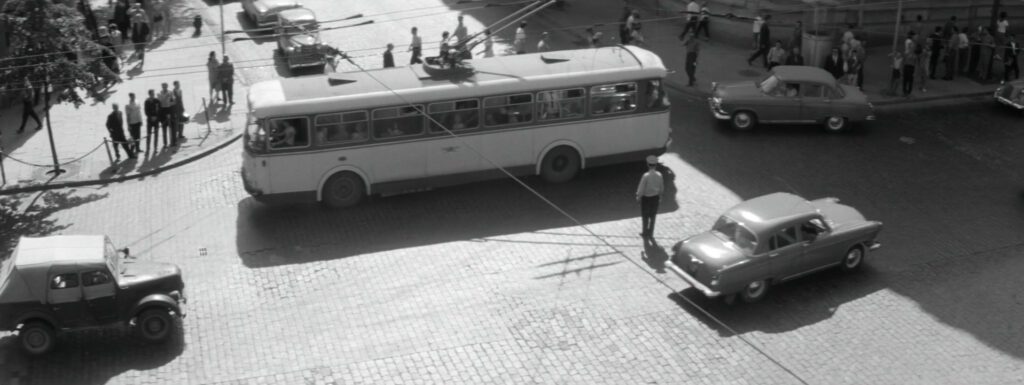
The hints of nuclear war gave viewers a timely and non-controversial way to read the film, but the central interlude works equally well as a metaphor for Lithuania’s occupation. It expresses not only the horror and disruption of Soviet tyranny, but also the stasis of being locked in a hopeless situation. If we look at the film this way, the return to normalcy is more convincing. Instead of wishful thinking (“The war was only a bad dream”) it expresses a realistic hope for an independent future, diminished only by the brief and obligatory Soviet flag-waving.
In any case the prevailing effect of the central section is not so much a political narrative as a shift in the sense of time. When the film begins, the clock turns and the bell chimes the hours, crowds fill the streets, construction workers bring progress, and the air is filled with jazzy music. There’s a sense of time moving forward – but when life comes to a halt and the clock’s gears stop, there’s a sense of being frozen in time. At first the stoppage evokes catastrophe, but the horse brings in a feeling of hope. The stately animal is a picture of peace and dignity, yet it fits the central passage’s feeling of eternal time. This is certainly no accident. Most serious films build to a sense of eternity, and directors like Ozu, Bergman, Antonioni, and Mizoguchi were particularly aware of this. The timeless perspective of eternity helps to reconcile viewers to their difficulties and disappointments, and it opens space for a new appreciation of life.
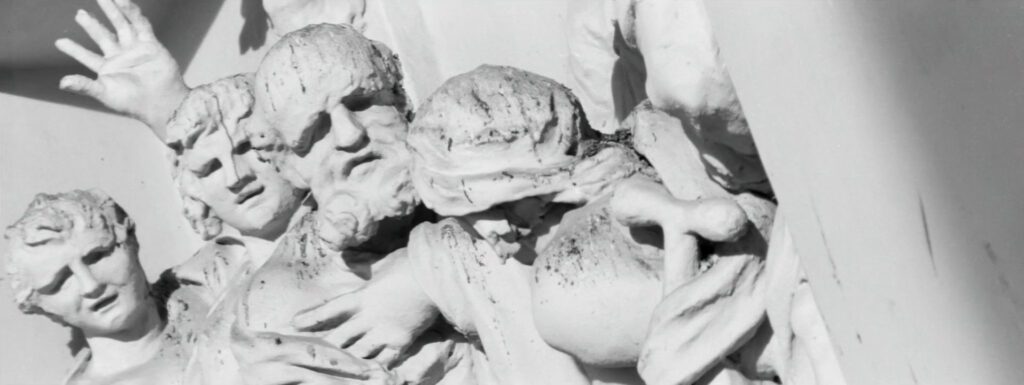
Unspoken amid all the invocations of eternity is the connection between Vilnius and Rome, the “Eternal City”. Vilnius is nicknamed “Rome of the North” for its profusion of churches, its hilly landscape, and its historic conversion from paganism to Christianity. The architecture and sculptures in Time Walks Through the City bolster the link to Rome, and the horse has the noble bearing of an ancient equestrian statue. The film ends with some panoramas of Vilnius, the last one viewed from Gediminas Tower, the symbol of Lithuania. By this point we should sense that the city’s eternal qualities are more than a slogan.
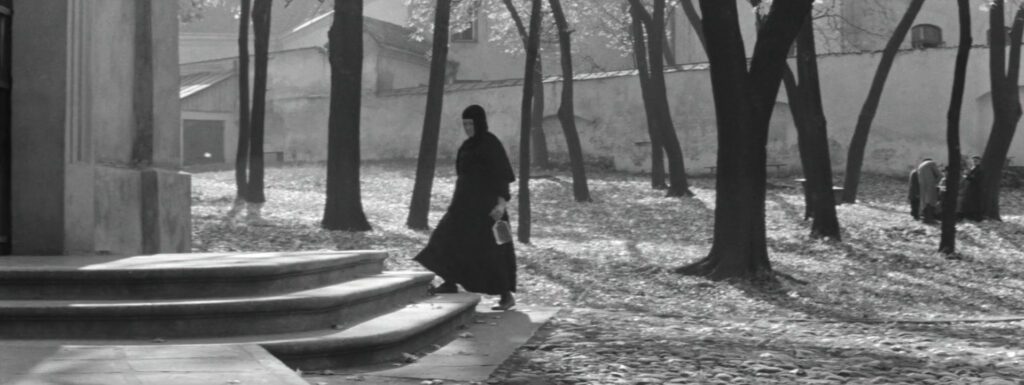
Time Walks Through the City opens with a few lines by Lithuanian poet Justinas Marcinkevičius:
“The cracked wall of the old city tells of man’s history with the economy of modern means, as if it were a gray screen. Of course, we get tired. And, of course, we make mistakes. Still we refuse to turn our back to the wall and try to understand it instead.”
The fortified medieval wall that defines the old city of Vilnius is akin to the national borders that define Lithuania, and which must have felt sacred to its citizens who yearned for independence. The lines from Marcinkevičius’ poem place the wall in the context of history, saying that however tired and defeated we may feel, we will seek to understand. This too is what the film aims for, encouraging viewers not only to see their nation in the present tense but to understand it within a more comprehensive vision of time.
CONNECTIONS:
Late Spring – Contrast between tradition and modernity to express the passage of time
Tokyo Story – Systematic distinction between clock time, eternity, and cyclical time
La notte – Shots of modern architecture composed like abstract paintings; preoccupation with time
L’eclisse – Montage of urban details, including contrails, with visual echoes to create a sense of familiarity
NOTE:
This film is available for free streaming at http://www.sinemateka.lt/en/documentary#time-passes-through-the-city. The site features a small collection of Lithuanian short films and documentaries, and it is well worth exploring.